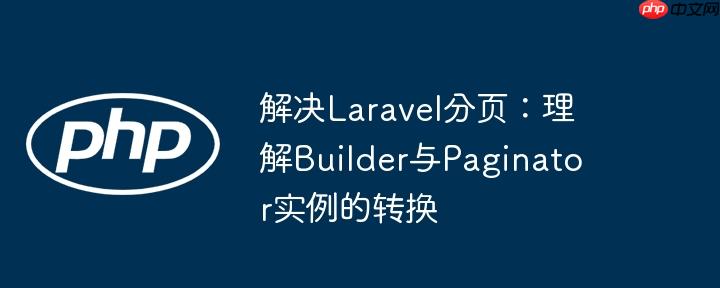
在Laravel中,当我们使用Eloquent模型或DB门面构建查询时,我们操作的是一个Illuminate\Database\Eloquent\Builder(对于Eloquent)或Illuminate\Database\Query\Builder(对于DB门面)实例。这些实例提供了一系列链式方法,如select(), where(), join(), orderBy()等,用于逐步构建SQL查询。
然而,像get(), first(), count()以及paginate()这样的方法是“终端操作”或“执行操作”。它们的作用是执行之前构建的查询,并返回查询结果。特别地,paginate()方法会执行查询并返回一个Illuminate\Pagination\LengthAwarePaginator或Illuminate\Pagination\Paginator实例,而不是原有的查询构建器实例。
Laravel的links()方法是Paginator实例特有的,用于生成分页链接的HTML。如果尝试在一个Builder实例上调用links(),就会抛出Call to undefined method错误,因为Builder类并没有这个方法。
考虑以下Laravel控制器中的postFilter方法,它用于处理带过滤条件的数据查询:
public function postFilter(Request $request)
{
try {
$con = 'mysql_prod';
$items = Item::on($con)->select(['items.name AS item_name', 'items.slug', 'items.id AS item_id', 'item_details.sticker_number', 'item_details.section', 'item_details.type', 'collections.name AS collections_name', 'collections.sport_type', 'collections.league', 'collections.year as collections_year', 'images.file_name'])
->leftJoin('item_details', 'items.id', '=', 'item_details.items_id')
->leftJoin('collections', 'items.collections_id', '=', 'collections.id')
->leftJoin('images', 'images.items_id', '=', 'items.id');
// 应用过滤条件
if (!is_null($request->select_collection_field)) {
$items->where('collections.id', '=', intval($request->select_collection_field));
}
if (!is_null($request->select_filter_field)) {
if ($request->select_filter_field === "select_all") $items->orderBy('item_name', 'desc');
if ($request->select_filter_field === "publishing_year") $items->orderBy('collections_year', 'desc');
}
// 错误的用法:paginate()的返回值未被捕获
$items->limit(500)->paginate(10); // $items 变量仍然是 Query Builder 实例
// ... 其他过滤条件和数据获取 ...
return view('index', compact('items', 'condition', 'collection'));
} catch (\Exception $e) {
Log::error($e);
report($e);
}
}在上述代码中,尽管调用了$items->limit(500)->paginate(10);,但$items变量本身并未被重新赋值为paginate()方法的返回值。因此,当视图中尝试调用$items->links()时,$items仍然是一个Illuminate\Database\Eloquent\Builder实例,而不是期望的分页器实例,从而导致错误。
解决此问题的关键在于,必须将paginate()方法的返回值重新赋值给用于视图的变量。
public function postFilter(Request $request)
{
try {
$con = 'mysql_prod';
$query = Item::on($con)->select(['items.name AS item_name', 'items.slug', 'items.id AS item_id', 'item_details.sticker_number', 'item_details.section', 'item_details.type', 'collections.name AS collections_name', 'collections.sport_type', 'collections.league', 'collections.year as collections_year', 'images.file_name'])
->leftJoin('item_details', 'items.id', '=', 'item_details.items_id')
->leftJoin('collections', 'items.collections_id', '=', 'collections.id')
->leftJoin('images', 'images.items_id', '=', 'items.id');
// 应用过滤条件
if (!is_null($request->select_collection_field)) {
$query->where('collections.id', '=', intval($request->select_collection_field));
}
if (!is_null($request->select_filter_field)) {
if ($request->select_filter_field === "select_all") $query->orderBy('item_name', 'desc');
if ($request->select_filter_field === "publishing_year") $query->orderBy('collections_year', 'desc');
}
// 正确的用法:将 paginate() 的返回值赋值给 $items 变量
$items = $query->limit(500)->paginate(10); // $items 现在是 Paginator 实例
// ... 其他过滤条件和数据获取 ...
$condition = Condition::on($con)->select(['id', 'name AS condition_name'])
->distinct()
->get();
$collection = Collection::on($con)->select(['id', 'name AS collection_name'])
->distinct()
->orderBy('collection_name', 'ASC')
->get();
return view('index', compact('items', 'condition', 'collection'));
} catch (\Exception $e) {
Log::error($e);
report($e);
}
}在上述修正后的代码中,我们首先将查询构建过程赋值给一个临时变量(例如$query),然后将$query->limit(500)->paginate(10)的执行结果重新赋值给$items变量。这样,当$items被传递到视图时,它就是一个合法的Paginator实例,从而可以成功调用links()方法。
对于初始加载视图的方法getSearchView,也应采用相同的逻辑:
public function getSearchView()
{
try {
$con = 'mysql_prod';
// search results
$items = Item::on($con)->select(['items.name AS item_name', 'items.slug', 'items.id AS item_id', 'item_details.sticker_number', 'item_details.section', 'item_details.type', 'collections.name AS collections_name', 'collections.sport_type', 'collections.league', 'collections.year as collections_year', 'images.file_name'])
->leftJoin('item_details', 'items.id', '=', 'item_details.items_id')
->leftJoin('collections', 'items.collections_id', '=', 'collections.id')
->leftJoin('images', 'images.items_id', '=', 'items.id')
->limit(500)
->paginate(10); // 这里已经正确捕获了 paginate() 的返回值
// filter field
$condition = Condition::on($con)->select(['id', 'name AS condition_name'])
->distinct()
->get();
$collection = Collection::on($con)->select(['id', 'name AS collection_name'])
->distinct()
->orderBy('collection_name', 'ASC')
->get();
return view('index', compact('items', 'condition', 'collection'));
} catch (\Exception $e) {
Log::error($e);
report($e);
}
}可以看到,getSearchView方法中的$items = ... ->paginate(10);这一行本身就是正确的赋值操作,因此它不会出现同样的问题。
Call to undefined method Illuminate\Database\Eloquent\Builder::links()错误是Laravel开发者在使用分页功能时常见的陷阱。其根本原因在于混淆了查询构建器实例和分页器实例。通过理解paginate()方法作为终端操作的特性,并确保将其返回的分页器实例正确赋值给视图所使用的变量,可以有效解决此问题,使Laravel的分页功能正常工作。掌握这一核心概念,将有助于编写更健壮、更符合Laravel框架设计哲学的代码。
以上就是解决Laravel分页:理解Builder与Paginator实例的转换的详细内容,更多请关注php中文网其它相关文章!

每个人都需要一台速度更快、更稳定的 PC。随着时间的推移,垃圾文件、旧注册表数据和不必要的后台进程会占用资源并降低性能。幸运的是,许多工具可以让 Windows 保持平稳运行。

Copyright 2014-2025 https://www.php.cn/ All Rights Reserved | php.cn | 湘ICP备2023035733号